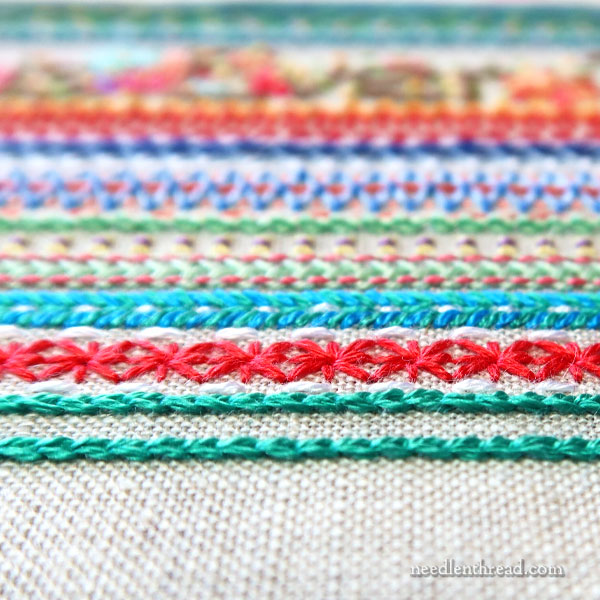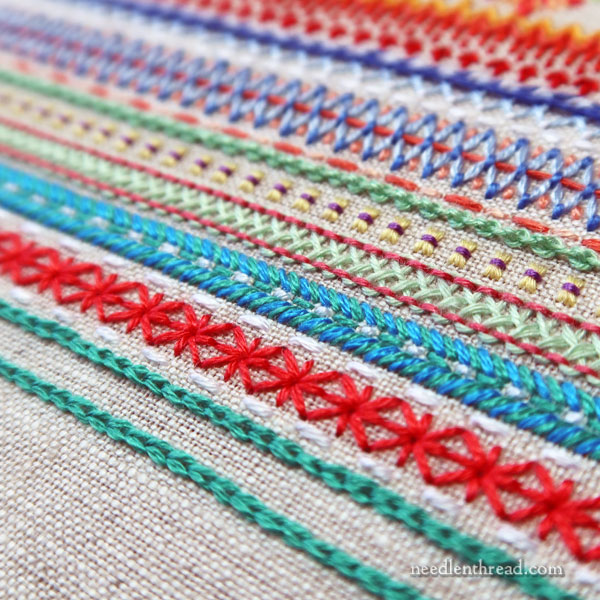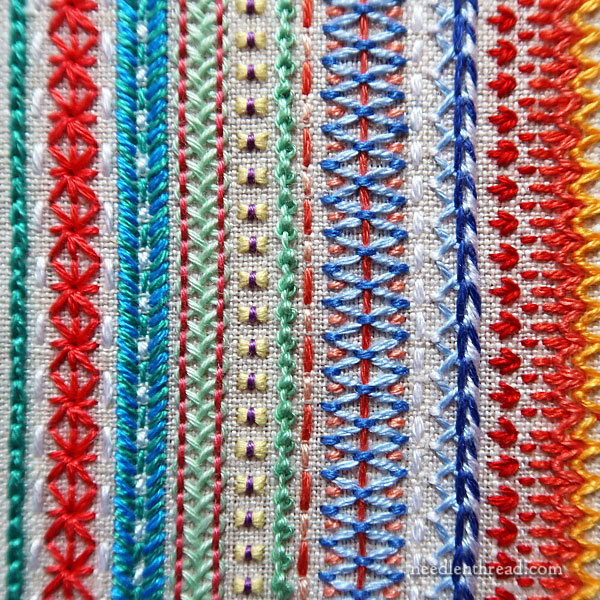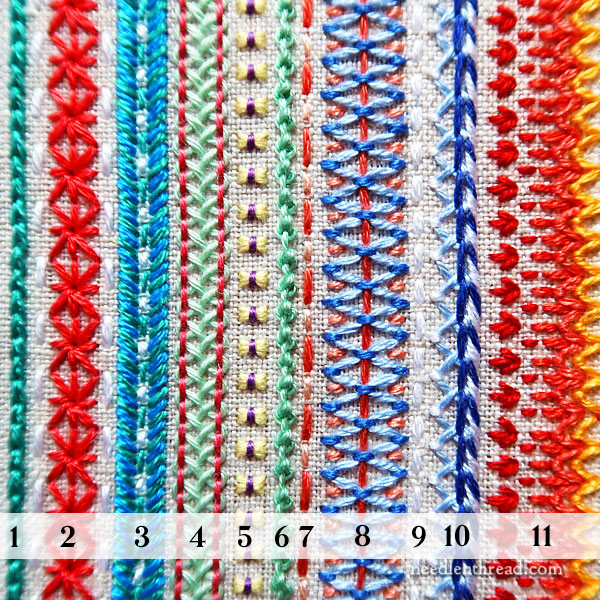Just a little Stitch Fun 2021 sampler update this morning, to kick off the week and the month of March!
Over the past couple weeks, I’ve been fiddling with a new camera – certainly no great, complicated thing. I just use a point and shoot for most of my blog photos. And often, I just use my phone.
But I need a regular camera for certain situations. And for the most part, it has to be a small, quick camera. If I have to tussle with a monster camera every time I needed to take a photo, I’d get nothing done.
My favorite all-time camera over these blogging years has been my trusty-rusty Canon G12. But I think I’ve practically used it to death. It’s starting to limp. So I invested in a new point and shoot – one of the latest in that line of Canon cameras – and galldernit, it has a learning curve. I think it’s going to be a great camera, as soon as the Interface to the Chair (that would be me) can figure out its nuances.
That’s my excuse, if you’re not keen on the images posted today!! I’m working on it!

I’m focusing here on the more recent lines of stitching.
The two green parallel lines of chain stitch that are going in right now are the foundations of another stitch that I had a hankering to add to the sampler. It’s called step stitch, and it’s a decorative band stitch – a composite of chain stitch, straight stitch, and a little wrapping.
I like composite stitches. A composite stitch is exactly what it sounds like – a stitch made up of two or more basic stitches, so that, taken all together, they form a new stitch. Most decorative band stitches are composite stitches. They start as chain stitch, or straight stitch, or backstitch, or … you get the idea … and then you build onto them with other stitches.
If you’ve worked any of the projects in my e-book Stitch Sampler Alphabet, you’re very family with composite stitches! There are dozens in there.

The red band of Algerian Eye stitch (they look like square stars) was the result of coming across a series of video tutorials on Instagram.
A good part of the concept behind the stitch is the open “eye” that results in the center. On the video, the method used completely obliterated any chance of an open eye.
So I thought I better pay homage to the stitch to make up for it.
I ended up using too much thread for the size of the stitches (I’m using three strands of DMC, and the stitches are maybe 3/16″ of an inch to the center point), so I ended up closing up the eye, too, in most cases.
That’s what I get for judgin’!

I rather like a vertical orientation on this piece. I end up doing a lot of the stitching on it vertically, and then when I turn it to horizontal, it throws me off a bit.
I might do a vertical section. I’ll have to break the sampler first. I have a slight urge to do a bit of free-form stuff that isn’t linear, or to add another quote that recently occurred to me. Either approach would create a visual break, after which I could go vertical for a short stretch if I still want to.
That’s the great thing about this kind of project. You can do whatever you want, when it occurs to you. And if you want to change your mind, you can do that, too!
Which Stitches?
Corresponding to the numbers in the photo below, you’ll find a list of the new bands since the last time we looked at this project.

1. The green chain stitch is part of the foundation of what will eventually be step stitch.
2. Red Algerian Eye, with a line of white running stitch on each side.
3. Half cross stitches, mirrored, in alternating green and blue (rather peacocky green and blue), with white running stitch down the center and green running stitch down the center of those mirrored lines.
4. There are many names for this pink and green band. Herringbone ladder filling. Interlaced band. Laced cretan. Double Pekinese. It’s essentially two backstitched lines (in pink) that are off-set from each other, and then the lines are laced (in green) with a cretan stitch movement, passing under the backstitches but not into the fabric.
5. Little bundles of yellow gathered in the center with a purple backstitch. This is sheaf stitch, more or less: groups of three straight stitches, overstitched in their center to bundle the straight stitches into what looks like a sheaf.
6. Just to the right of the yellow sheafs tied with purple, you’ll find a line of Palestrina stitch in green.
7. To the right of that, alternating running stitch in a dark coral and a light coral.
8. The big band of light blue, dark blue, dark coral and light coral is cloud filling, with a dark coral thread running under center straight holding stitches, and light coral straight stitches between the light blue lacings that form the diamond pattern.
9. A line of white running stitch. Why not? Never underestimate the running stitch when you need just a little something.
10. Chain stitch in dark blue, whipped on one side with white. On the other half, interlaced chain stitch band, in light blue couched with white.
11. A decorative composite of fly stitches and straight stitches. I started with a line of horizontal fly stitch in dark yellow, followed immediately by another line of the same in coral, and then added straight stitches falling off of those, in a darker coral, and ending with the red little groups of three (they look like bird feet) straight stitches. Very simple stitches, but it makes quite a nice, eye-catching decorative band.
I can’t promise to name every stitch I use on this sampler as the year marches on, but I’ll try to when I have time.
Stitch Tutorials
You will find tutorials for many of the stitches I’m using right here on Needle ‘n Thread.
You can find all my video tutorials listed here, where you’ll also find an alphabetical listing of stitch tutorials on the website, if you scroll past the video tutorials.
Here is the index for my Stitch Fun! series, where you’ll find a list of links to photo tutorials for many composite stitches and for some more obscure stitches.
More on Stitch Fun 2021 Sampler
If you want to explore previous articles on this sampler, you’ll find them all listed under the tag Stitch Fun 2021 here on Needle ‘n Thread. You can also find occasional updates on my Instagram, where I’m using the hashtag #stitchfun2021 for this project. If you’re working a similar project, feel free to use the hashtag so I can find you!
Have a wonderful Monday! I hope your week is off to a jolly start!







Morning Mary
The first couple paragraphs had me chuckling, especially the chair interface. Then we get into the band sampler which I’m finding fascinating. Loving your thoughts on different approaches as far as lines and inserts go. And then, the frosting on the cake, a detailed list of the composite stitches. Thank you – Brenda
I am looking forward to your sampler posts more and more as it progresses. I am such a stitch geek. #10 looks like its been laced like Chained Pekinese stitch am I right? Is it one of your improvisations or is it documented? If so would love to know in which of your stitch dictionaries you found it! I have most of what you shared the other day but did not see it. Love it !
It’s a mish-mash, Sharon. I didn’t find it as it is in a book. You know how it is when you start playing with stitches and combining stuff! What I did was work the left side (according to the vertical orientation of the fabric – it’s actually the lower part of the line, if the sampler is oriented correctly, horizontally) of the chain stitch in light blue as if I were doing an interlaced chain stitch band. That’s this thing: https://needlenthread.wpengine.com/2012/10/stitch-play-interlaced-chain-stitch.html – it shows up in a few books. I think it’s in Mary Thomas, probably in the one or the two of the A-Z of Embroidery Stitches, and others. I couched the interlaced stitches away from the chain stitch in a different color (white), drawing them out to a semi-point. Then I took the same white and whipped the other side of the chain stitch (the right looking vertically, or the top side, if you’re looking at it horizontally). Simple! 🙂
Dear Mary
Wow those stitches above look lovely and so different from each and so many new stitches this is great I’m really enjoying this and learning form it. I can’t for you show us the step stitch and how it’s done. Where did you see the tutorial for the step stitch I would like to see how it’s stitched. Your sampler is certainly coming along nicely and looks so lovely with all the different composite stitches I really look forward to the progress on this. Thank you for sharing with us the latest stitches on your 2021 sampler. Look forward to the progress on it.
Regards Anita Simmance
The sampler is really beautiful and I LOVE the colours!
Fantástico seu trabalho, obrigada por compartilhar seus dons!!!
The slow stitch sampler 2021, could you tell me the size of it and what type of linen it is please?
Hi, Joyce – I used a Graziano linen called “Manuscript Vellum” here in the States, and it’s 7″ wide and 36″ long, but I added cotton strips to the sides so that I could hoop it easily.